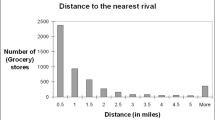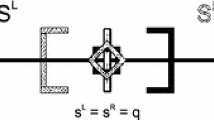Abstract
Firm entry into local markets has often been studied using administrative areas such as municipalities as the assumed relevant markets. However, administrative areas and the actual relevant markets based on local demand for firms’ products often do not coincide, which could bias the results of studies treating administrative areas as the relevant markets. Based on a behavioral assumption regarding how retailers act when purchasing products from wholesale trade firms, we create alternative markets using Voronoi diagrams. We then compare the empirical results of investigating the determinants of firm entry using municipalities as the relevant markets with the results obtained using Voronoi markets. The results indicate that, in both cases, the same variables are statistically significant in affecting entry, though the estimated effects differ in size.


Similar content being viewed by others
Notes
See, for example, Pakes and Ericson (1998) for a comprehensive overview of the various econometric models employed in firm entry analysis.
From 1991 to 2009, NUTEK was a Swedish agency responsible for promoting economic and regional growth. In 2009, NUTEK and other government organizations in Sweden with similar responsibilities were restructured to create the new organization Tillväxtverket.
Note that if one could make reasonable assumptions to create the demand areas for individual firms in other industries, then the method suggested here would be general enough to be used for studying other sectors and industries as well.
Market Manager Partner is a consulting firm now merged with the business communication firm PAR. PAR acquired the firm data directly from the Swedish Patent and Registration Office.
These industries are defined using the European Union NACE standards.
The inclusion of multi-plant firms in the analysis would increase the number of relevant markets using the Voronoi technique, particularly in densely populated areas, where most plants are located. Meanwhile, the overall geographical pattern of the relevant markets would remain similar, geographically larger markets being found in northern Sweden and smaller ones in the south.
These indicator variables are omitted from the result tables to save space, but are available from the authors on request. In addition, Eq. (5) was estimated without NACE code-specific indicator variables to investigate whether the results are sensitive to model specification. The results of these estimations are similar to those reported below and are available from the authors on request.
The indicator variables for infrastructure and the presence of a university or university collage have in some additional estimations been replaced by the distance from the local market to the university or infrastructure. For all variables except the indicator variable for type of local government, the qualitative results remain the same as presented below, while the indicator variable for local government turns out to be statistically insignificant in these estimations. Since the Schwarz’s Bayesian information criterion clearly favors the models using the indicator variables when analyzing firm entry, the results using these indicator variables are the ones presented below. Results from the alternative estimations are available from the authors on request.
References
Acs JZ, Audretsch DB, Braunerhjelm P, Carlsson B (2009) The knowledge spillover theory of entrepreneurship. Small Bus Econ 32:15–30
Armington C, Acs JZ (2002) The determinants of variation in new firm formations. Reg Stud 36:33–45
Berger S, Forsberg G (2005) Planeringens utmaningar och tillämpningar. Uppsala Publishing House, Uppsala
Berglund E, Brännäs K (2001) Plants’ entry and exit in Swedish municipalities. Ann Reg Sci 35:431–449
Bosma N, van Stel A, Suddle K (2008) The geography of new firm formation: evidence from independent start-ups and new subsidiaries in the Netherlands. Int Entrep Manag J 4:129–146
Braunerhjelm P, Borgman B (2004) Geographical concentration, entrepreneurship and regional growth: evidence from regional data in Sweden 1975–1999. Reg Stud 38:929–947
Daunfeldt SO, Rudholm N, Bergström F (2006) Entry into Swedish retail and wholesale trade markets. Rev Ind Organ 29:213–225
Daunfeldt SO, Lang Å, Macuchova Z, Rudholm N (2013a) Firm growth in the Swedish retail and wholesale industries. Serv Ind J 33:1193–1205
Daunfeldt SO, Elert N, Rudholm N (2013b) New start-ups and firm in-migration: evidence from the Swedish wholesale trade industry. Ann Reg Sci 51:479–494
Elander I (1978) Det nödvändiga och det önskvärda: en studie av socialdemokratisk ideologi och regionalpolitik 1940–72. Dissertation, University of Stockholm, Stockholm
Fritsch M, Mueller P (2008) The effect of new firm formation on regional development over time: the case of Germany. Small Bus Econ 30:15–29
Geroski PA (1995) What do we know about entry? Int J Ind Organ 13:421–440
Håkansson J, Macuchova Z, Rudholm N (2013) Firm migration in the Swedish wholesale trade sector. Int Rev Retail Distrib Consum Res 23:48–64
Johnson P, Parker S (1996) Spatial variations in the determinants and effects of firm births and deaths. Reg Stud 30:679–688
Long JS, Freese J (2006) Regression models for categorical dependent variables using Stata, 2nd edn. Stata Press, College Station
Marshall A (1890) Principles of economics. Macmillan, London
Nyström K (2007) An industry disaggregated analysis of the determinants of regional entry and exit. Ann Reg Sci 44:877–896
Pakes A, Ericson R (1998) Empirical implications of alternative models of firm dynamics. J Econ Theory 79:1–45
Pellenbarg PH, van Wissen LJG, van Dijk J (2002) Firm migration. In: McCann P (ed) Industrial location economics. Edward Elgar Publishing, Cheltenham
Strotman H (2007) Entrepreneurial survival. Small Bus Econ 28:87–104
Acknowledgments
We would like to thank participants at the 3rd Nordic Retail and Wholesale Association Conference in Lund, Sweden, as well as participants at the 7th HUI Workshop in Retailing, at Mälargården, Sweden, for valuable comments and suggestions. Financial support from the Swedish Retail and Wholesale Development Council is gratefully acknowledged.
Author information
Authors and Affiliations
Corresponding author
Rights and permissions
About this article
Cite this article
Brandt, D., Macuchova, Z. & Rudholm, N. Firm entry in the Swedish wholesale trade sector: Does market definition matter?. Ann Reg Sci 53, 703–717 (2014). https://doi.org/10.1007/s00168-014-0639-8
Received:
Accepted:
Published:
Issue Date:
DOI: https://doi.org/10.1007/s00168-014-0639-8




